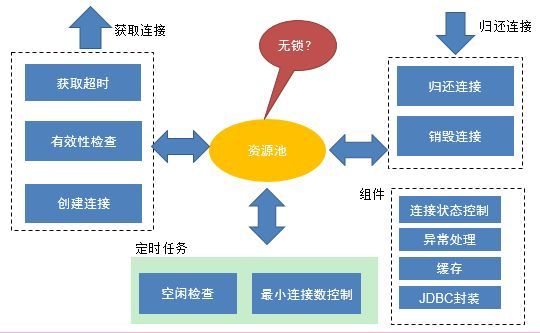自定义连接池实现
public class ConnectionPool {
private LinkedList<Connection> pool = new LinkedList<Connection>();
/**
* 初始化连接池的大小
* @param initialSize
*/
public ConnectionPool(int initialSize) {
if (initialSize > 0) {
for (int i = 0; i < initialSize; i++) {
pool.addLast(ConnectionDriver.createConnection());
}
}
}
/**
* 释放连接,放回到连接池
* @param connection
*/
public void releaseConnection(Connection connection){
if(connection != null){
synchronized (pool) {
// 连接释放后需要进行通知,这样其他消费者能够感知到连接池中已经归还了一个连接
pool.addLast(connection);
pool.notifyAll();
}
}
}
/**
* 在mills内无法获取到连接,将会返回null
* @param mills
* @return
* @throws InterruptedException
*/
public Connection fetchConnection(long mills) throws InterruptedException{
synchronized (pool) {
// 无限制等待
if (mills <= 0) {
while (pool.isEmpty()) {
pool.wait();
}
return pool.removeFirst();
}else{
long future = System.currentTimeMillis() + mills;
long remaining = mills;
while (pool.isEmpty() && remaining > 0) {
// 等待超时
pool.wait(remaining);
remaining = future - System.currentTimeMillis();
}
Connection result = null;
if (!pool.isEmpty()) {
result = pool.removeFirst();
}
return result;
}
}
}
}public class ConnectionDriver {
static class ConnectionHandler implements InvocationHandler{
@Override
public Object invoke(Object proxy, Method method, Object[] args) throws Throwable {
if(method.equals("commit")){
TimeUnit.MILLISECONDS.sleep(100);
}
return null;
}
}
/**
* 创建一个Connection的代理,在commit时休眠100毫秒
* @return
*/
public static final Connection createConnection(){
return (Connection) Proxy.newProxyInstance(ConnectionDriver.class.getClassLoader(),
new Class[] { Connection.class },new ConnectionHandler());
}
}public class ConnectionPoolTest {
static ConnectionPool pool = new ConnectionPool(10);
// 保证所有ConnectionRunner能够同时开始
static CountDownLatch start = new CountDownLatch(1);
// main线程将会等待所有ConnectionRunner结束后才能继续执行
static CountDownLatch end;
public static void main(String[] args) {
// 线程数量,可以修改线程数量进行观察
int threadCount = 10;
end = new CountDownLatch(threadCount);
int count = 20;
AtomicInteger got = new AtomicInteger();
AtomicInteger notGot = new AtomicInteger();
for (int i = 0; i < threadCount; i++) {
Thread thread = new Thread(new ConnetionRunner(count, got, notGot), "ConnectionRunnerThread");
thread.start();
}
start.countDown();
try {
end.await();
} catch (InterruptedException e) {
e.printStackTrace();
}
System.out.println("total invoke: " + (threadCount * count));
System.out.println("got connection: " + got);
System.out.println("not got connection " + notGot);
}
static class ConnetionRunner implements Runnable {
int count;
AtomicInteger got;
AtomicInteger notGot;
public ConnetionRunner(int count, AtomicInteger got, AtomicInteger notGot) {
this.count = count;
this.got = got;
this.notGot = notGot;
}
@Override
public void run() {
try {
start.await();
} catch (Exception ex) {
}
while (count > 0) {
try {
// 从线程池中获取连接,如果1000ms内无法获取到,将会返回null
// 分别统计连接获取的数量got和未获取到的数量notGot
Connection connection = pool.fetchConnection(1);
if (connection != null) {
try {
connection.createStatement();
connection.commit();
} finally {
pool.releaseConnection(connection);
got.incrementAndGet();
}
} else {
notGot.incrementAndGet();
}
} catch (Exception ex) {
} finally {
count--;
}
}
end.countDown();
}
}
}total invoke: 200
got connection: 200
not got connection 0total invoke: 1000
got connection: 999
not got connection 1total invoke: 2000
got connection: 1842
not got connection 158正文到此结束
- 本文标签: 连接池实现
- 版权声明: 本文由HARRIES原创发布,转载请遵循《署名-非商业性使用-相同方式共享 4.0 国际 (CC BY-NC-SA 4.0)》许可协议授权
- 本文海报: 生成海报一 生成海报二
热门推荐
相关文章
Loading...












![[HBLOG]公众号](http://www.liuhaihua.cn/img/qrcode_gzh.jpg)

